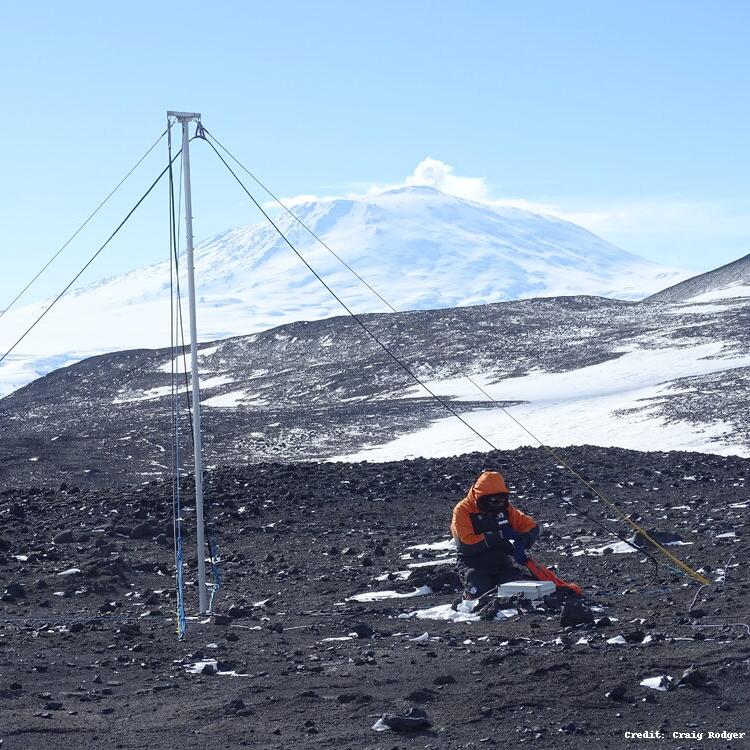Very Low Frequency Radio Observations of Lightning Discharges at Scott Base
The WWLLN Very Low Frequency (VLF) Radio Sensor was installed at Scott Base in November 2015 by Dr. James Brundell and Ms. Emma Douma as part of Antarctica New Zealand Event K060-1516-A. The sensor measures the electric field in the Very Low Frequency radio range (~500 Hz-50 kHz) and passes it to a PC which processes the data for the experiments.
The antenna is located behind the Hatherton lab. It was installed due to increasing manmade electromagnetic noise levels in the "quiet zone" at Arrival Heights. The observations from this antenna are now the primary WWLLN feed from Ross Island, the Arrival Height's magnetic field antenna is now a backup. WWLLN, uses the VLF feed but processes it to detect the radio-wave pulses from lightning. WWLLN observations are sent to a central processing computer to determine the time and location of lightning pulses all over the globe. The World Wide Lightning Location Network (WWLLN) is an experimental Very Low Frequency (VLF) network of sensors being developed through collaborations with research institutions across the globe. The network exploits the considerable electromagnetic power radiated by lightning as "sferics" present in the VLF band. By combining radio-pulse observations from at least 5 stations, the WWLLN central processing computers can determine the location of the original lightning discharge. As the radio-pulse observations are immediately sent back across the internet to the central processing computers locations are generated within ~10 s of the discharge, and thus near real time. There are currently about 70 active VLF receiving stations operating in the VLF World-Wide Lightning Location Network, including the Scott Base measurements. WWLLN observations are continuously transmitted to one of the WWLLN primary servers, in this case flash.ess.washington.edu at the University of Washington, Seattle, USA.
Simple
- Date (Creation)
- 2023-08-11T22:58:27
- Date (Publication)
- 2023-08-11T22:58:27
Citation identifier
- Status
- On going
- Point of contact
-
Organisation name Individual name Electronic mail address Role World Wide Lightning Location Network
Publisher Rodger, C.
Author
- Maintenance and update frequency
- As needed
- Date of next update
- 2023-08-11T22:58:31
- Keywords
-
-
INSTALLATION
-
K060A
-
- GCMD Earth Science and Earth Science Services Keywords
-
-
LIGHTNING
-
ATMOSPHERIC ELECTRICITY
-
- GCMD Platform/Sources Keywords
-
-
GROUND STATIONS
-
- GCMD Instrument/Sensors Keywords
-
-
VLF RECEIVERS
-
- GCMD Project Keywords
-
-
AARDDVARK
-
WWLLN
-
- GCMD Locations Keywords
-
-
ANTARCTICA
-
ROSS ISLAND
-
- Use limitation
-
This data set conforms to the CC BY Attribution License ( https://creativecommons.org/licenses/by/4.0/ )
- Hierarchy level
- Dataset
- Date
- Statement
-
Creative Commons Attribution 4
- gmd:disseminationConstraints
- License
- Access constraints
- License
- Use constraints
- License
- Language
- English
- Character set
- UTF8
- Topic category
-
- Climatology, meteorology, atmosphere
Extent
))

- Begin date
- 2015-11-23T00:00:00
- Distribution format
-
Name Version
Metadata
- File identifier
- a998b777-ba36-4562-99fc-4ae4d21039cd XML
- Metadata language
- English
- Character set
- anyValidURI
- Hierarchy level
- Dataset
- Date stamp
- 2024-07-16T05:46:21.588Z
- Metadata standard name
-
ISO 19115
- Metadata standard version
-
2003
- Metadata author
-
Organisation name Individual name Electronic mail address Role World Wide Lightning Location Network
Point of contact


